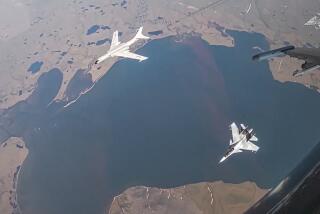China ups ante in conflict with Japan with new air defense ID zone
BEIJING -- Upping the gamesmanship with Japan over disputed East China Sea waters, China said Saturday it had established an air defense identification zone that would allow its military to take “emergency defensive measures” against unidentified aircraft.
The Chinese Defense Ministry said that aircraft flying through the zone would be required to identify themselves and implied that those in violation could be shot down.
To underscore the threat, the air force conducted its first patrol at 10 a.m. Saturday, using two reconnaissance planes accompanied by early-warning aircraft and fighter jets “providing support and cover.”
China insisted that the establishment of the zone wouldn’t impede normal commercial air traffic.
“The patrol is in line with international common practices, and the normal flight of international flights will not be affected,” Shen Jinke, a spokesman for the Peoples Liberation Army air force, was quoted telling the state press.
As predictable in the diplomatic war of words with Japan, Tokyo denounced the zone as unacceptable and “very dangerous.”
“Setting up such airspace unilaterally escalates the situations surrounding Senkaku islands and has danger of leading to an unexpected situation,” Japan’s Foreign Ministry said in a statement.
The Chinese released a map of the zone Saturday which includes the uninhabited islets known as the Senkakus by the Japanese and as Diaoyu by mainland China, and extends as far east as 78 miles from Japan’s Okinawa Island.
The easternmost point of the new zone “is so close to China that combat aircraft can soon reach China’s territorial airspace from the point,” said a Chinese Defense Ministry spokesman Yang Yajun in an interview posted online Saturday.
“Therefore it is necessary for China to identify any aircraft from this point to assess its intentions and examine its identity so as to allow enough early-warning time for responsive measures in maintaining air security.”
In the interview, the defense ministry did not mention Japan directly, referring to it only as “some country.”
The Chinese defense spokesman noted in the interview that some 20 other countries have similar air defense identification zones. The statement suggested that China also plans a similar zone over the South China Sea, where it is locked in territorial disputes with Vietnam and the Philippines, among others.
The rules require that aircraft report their flight plans, maintain two-way radio communication and clearly display their nationality and identification.
“I don’t know that this is specifically directed against Japan, so much as it is the Chinese feeling that every modern country should have an air defense identification zone,” said Bonnie Glaser of the Washington-based Center for Strategic and International Studies.
The move comes less than two weeks after the conclusion of the Communist Party’s Third Plenum, in which the Chinese government established a new national security council with President Xi Jinping at its head.
In the last two years, China and Japan have stepped up their long-running dispute over the islets, with frequent face-offs by ships and aircraft. Incidents dropped off slightly since the summer, but some security analysts believe the lull is more weather-related than strategic.
“There are Japanese analysts who think tensions have eased a bit, but it has to do with the number of typhoons. I don’t think the Chinese are preparing to make any compromises,” said Glaser.
ALSO:
Kerry, other diplomats join Iran talks but express caution
Honduras presidential campaign shakes up the status quo
Aung San Suu Kyi, and Myanmar, faces an uncertain future
Twitter: @BarbaraDemick
More to Read
Sign up for Essential California
The most important California stories and recommendations in your inbox every morning.
You may occasionally receive promotional content from the Los Angeles Times.









